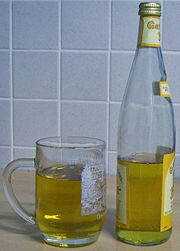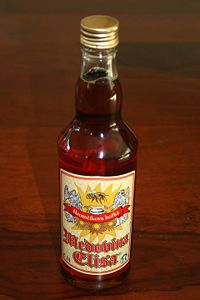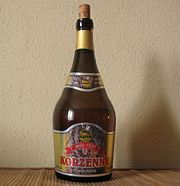Mead

Mead (IPA: /ˈmiːd/) is a beverage typically alcoholic, made from honey and water, by fermentation with yeast. Its alcoholic content may range from that of a mild ale to that of a strong wine. It may be still, carbonated, or sparkling. It may be dry, semi-sweet, or sweet. While it is often referred to as "honey wine",[1] technically mead is no more a honey wine than beer is a malt wine.
Depending on local traditions and specific recipes, it may be brewed with spices, fruits, or grain mash. It may be produced by fermentation of honey with grain mash;[2] mead may also, like beer, be flavored with hops[3] to produce a bitter, beer-like flavor.
Mead is independently multicultural. It is known from many sources of ancient history throughout Europe, Africa and Asia, although archaeological evidence of it is ambiguous.[4] Its origins are lost in prehistory.
Contents |
History
The first known description of mead is in the hymns of the Rigveda,[5] one of the sacred books of the historical Vedic religion and (later) Hinduism dated around 1700–1100 BC. During the "Golden Age" of Ancient Greece, mead was said to be the preferred drink.[6] Aristotle (384–322 BC) discussed mead in his Meteorologica and elsewhere, while Pliny the Elder (AD 23–79) called mead militites in his Naturalis Historia and differentiated wine sweetened with honey or "honey-wine" from mead.[7]
Around AD 550, the Cumbric speaking bard Taliesin wrote the Kanu y med or "Song of Mead."[8] The legendary drinking, feasting and boasting of warriors in the mead hall is echoed in the mead hall Dyn Eidyn (modern day Edinburgh), and in the epic poem Y Gododdin, both dated around AD 700. The Heorot in the Anglo-Saxon epic poem Beowulf also was known to host the drinking of mead.
Mead was the historical beverage par excellence and commonly brewed by the Germanic tribes in Northern Europe. However, heavy taxation and regulations governing the ingredients of alcoholic beverages led to commercially made mead becoming a more obscure beverage until recently.[9] Some monasteries kept up the old traditions of mead-making as a by-product of beekeeping, especially in areas where grapes could not be grown.
In many parts of Europe it was traditional to supply a newly married couple with enough mead for a month, ensuring happiness and fertility. Though some believe it is from this practice we get the word honeymoon[10][11], this etymology is not accepted by linguists.
Etymology
The English word mead derives from the Old English medu, from Proto-Germanic *meduz. Slavic miod / med, which means "honey", and Baltic *midus, which means "mead", derive from the same Proto-Indo-European root (cf. Welsh medd, Old Irish mid, and Sanskrit madhu).[12]
Distribution
Mead was also popular in Central Europe and in the Baltic states. In Polish, mead is called miód pitny (IPA: [mjut pitnɨ]), meaning "drinkable honey". In Russia, mead remained popular as medovukha and sbiten long after its decline in popularity in the West. Sbiten is often mentioned in the works of 19th-century Russian writers, including Gogol, Dostoevsky and Tolstoy.
In Finland, a sweet mead called Sima (cognate with zymurgy), is still an essential seasonal brew connected with the Finnish Vappu (May Day) festival. It is usually spiced by adding both the pulp and rind of a lemon. During secondary fermentation, raisins are added to control the amount of sugars and to act as an indicator of readiness for consumption; they will rise to the top of the bottle when the drink is ready.
Ethiopian mead is called tej (ጠጅ, IPA: [ˈtʼədʒ]) and is usually home-made. It is flavored with the powdered leaves and bark of gesho, a hop-like bittering agent which is a species of buckthorn. A sweeter, less-alcoholic version called berz, aged for a shorter time, is also made. The traditional vessel for drinking tej is a rounded vase-shaped container called a berele.
Mead known as iQhilika is traditionally prepared by the Xhosa of South Africa.
In literature
Mead features prominently in several of the works of Neil Gaiman. Early in the novel American Gods, the protagonist drinks a particularly unpleasant round of mead (colorfully described as tasting of "drunken diabetic's piss") with his new employer Mr. Wednesday to seal their contract. It is also a favorite drink of the title character of Gaiman's celebrated Sandman series.
In the novel The Wolves of Willoughby Chase by Joan Aiken, Bonnie and Sylvia are offered metheglin to hearten them for the walk.
In the Thomas Pynchon novel Gravity's Rainbow, the character Pirate Prentice serves homemade banana mead at his "Banana Breakfasts."
Mead is the favorite beverage of the skin-changer Beorn in Tolkien's The Hobbit.
Mead is featured in Beowulf, where the main character fights the evil Grendel at the mead-hall.
- See also: Mead of Poetry (Norse mythology)
Varieties

Mead can have a wide range of flavors, depending on the source of the honey, additives (also known as "adjuncts" or "gruit"), including fruit and spices, the yeast employed during fermentation, and aging procedure. Mead can be difficult to find commercially, though some producers have been successful in marketing it. Some producers have marketed white wine with added honey as mead, often spelling it "meade". This is closer in style to a Hypocras. Blended varieties of mead may be known by either style represented. For instance, a mead made with cinnamon and apples may be referred to as either a cinnamon cyser or an apple metheglin.
A mead that also contains spices (such as cloves, cinnamon or nutmeg), or herbs (such as oregano, hops, or even lavender or chamomile), is called a metheglin (IPA: /mɨˈθɛglɪn/).[13][14]
A mead that contains fruit (such as raspberry, blackberry or strawberry) is called a melomel[15], which was also used as a means of food preservation, keeping summer produce for the winter. A mead that is fermented with grape juice is called a pyment.[16]
Mulled mead is a popular drink at Christmas time, where mead is flavored with spices (and sometimes various fruits) and warmed, traditionally by having a hot poker plunged into it.
Some meads retain some measure of the sweetness of the original honey, and some may even be considered as dessert wines. Drier meads are also available, and some producers offer sparkling meads. There are a number of faux-meads, which are actually cheap wines with large amounts of honey added, to produce a cloyingly sweet liqueur.
| “ | Take of spring water what quantity you please, and make it more than blood-warm, and dissolve honey in it till 'tis strong enough to bear an egg, the breadth of a shilling; then boil it gently near an hour, taking off the scum as it rises; then put to about nine or ten gallons seven or eight large blades of mace, three nutmegs quartered, twenty cloves, three or four sticks of cinnamon, two or three roots of ginger, and a quarter of an ounce of Jamaica pepper; put these spices into the kettle to the honey and water, a whole lemon, with a sprig of sweet-briar and a sprig of rosemary; tie the briar and rosemary together, and when they have boiled a little while take them out and throw them away; but let your liquor stand on the spice in a clean earthen pot till the next day; then strain it into a vessel that is fit for it; put the spice in a bag, and hang it in the vessel, stop it, and at three months draw it into bottles. Be sure that 'tis fine when 'tis bottled; after 'tis bottled six weeks 'tis fit to drink.[17] | ” |
Historically, meads were fermented by wild yeasts and bacteria (as noted in the above quoted recipe) residing on the skins of the fruit or within the honey itself. Wild yeasts generally provide inconsistent results, and in modern times various brewing interests have isolated the strains now in use. Certain strains have gradually become associated with certain styles of mead. Mostly, these are strains that are also used in beer or wine production. However, several commercial labs, such as White Labs, WYeast, Vierka, have developed yeast strains specifically for mead.
Mead can be distilled to a brandy or liqueur strength. Krupnik is a sweet Polish liqueur made through such a process. A version of this called "honey jack" can be made by partly freezing a quantity of mead and pouring off the liquid without the ice crystals (a process known as freeze distillation), in the same way that applejack is made from cider.
Mead variants


- Braggot — Braggot (also called bracket or brackett). Originally brewed with honey and hops, later with honey and malt — with or without hops added.
- Black mead — A name sometimes given to the blend of honey and blackcurrants.
- Capsicumel is a mead flavored with chile peppers.
- Chouchenn is a kind of mead made in Brittany.
- Cyser — A blend of honey and apple juice fermented together; see also cider.
- Czwórniak — A Polish mead, made using three units of water for each unit of honey
- Dwójniak — A Polish mead, made using equal amounts of water and honey
- Great mead — Any mead that is intended to be aged several years. The designation is meant to distinguish this type of mead from "short mead" (see below).
- Gverc or Medovina — Croatian mead prepared in Samobor and many other places. The word “gverc” or “gvirc” is from the German "Gewürze" and refers to various spices added to mead.
- Hydromel — Hydromel literally means "water-honey" in Greek. It is also the French name for mead. (Compare with the Spanish hidromiel and aquamiel, Italian idromele and Portuguese hidromel). It is also used as a name for a very light or low-alcohol mead.
- Medica — Slovenian variety of Mead.
- Medovina — Czech, Serbian, Croatian, Bulgarian, and Slovak for mead. Commercially available in Czech Republic, Slovakia and presumably other Central and Eastern European countries.
- Medovukha — Eastern Slavic variant (honey-based fermented drink)
- Melomel — Melomel is made from honey and any fruit. Depending on the fruit-base used, certain melomels may also be known by more specific names (see cyser, pyment, morat for examples)
- Metheglin — Metheglin starts with traditional mead but has herbs and/or spices added. Some of the most common metheglins are ginger, tea, orange peel, nutmeg, coriander, cinnamon, cloves or vanilla. Its name indicates that many metheglins were originally employed as folk medicines. The Welsh word for mead is medd, and the word "metheglin" derives from meddyglyn, a compound of meddyg, "healing" + llyn, "liquor".
- Morat — Morat blends honey and mulberries.
- Mulsum — Mulsum is not a true mead, but is unfermented honey blended with a high-alcohol wine.
- Omphacomel — A mediæval mead recipe that blends honey with verjuice; could therefore be considered a variety of pyment (qv).
- Oxymel — Another historical mead recipe, blending honey with wine vinegar.
- Pitarrilla — Mayan drink made from a fermented mixture of wild honey, balche tree bark and fresh water.
- Pyment — Pyment blends honey and red or white grapes. Pyment made with white grape juice is sometimes called "white mead."
- Półtorak — A Polish mead, made using two units of honey for each unit of water
- Rhodomel — Rhodomel is made from honey, rose hips, petals or rose attar and water.
- Sack mead — This refers to mead that is made with more copious amounts of honey than usual. The finished product retains an extremely high specific gravity and elevated levels of sweetness. It derives its name, according to one theory, from the fortified dessert wine Sherry (which is sometimes sweetened after fermentation and in England once bore the nickname of "sack");[18] another theory is that the term derived from the Japanese drink sake, being introduced by Spanish and Portuguese traders.[19]
- Short mead — Also called "quick mead". A type of mead recipe that is meant to age quickly, for immediate consumption. Because of the techniques used in its creation, short mead shares some qualities found in cider (or even light ale): primarily that it is effervescent, and often has a cidery taste. It can also be champagne-like.
- Show mead — A term which has come to mean "plain" mead: that which has honey and water as a base, with no fruits, spices or extra flavorings. Since honey alone often does not provide enough nourishment for the yeast to carry on its lifecycle, a mead that is devoid of fruit, etc. will sometimes require a special yeast nutrient and other enzymes to produce an acceptable finished product. In most competitions (including all those using the BJCP style guidelines as well as the International Mead Fest) the term "traditional mead" is used for this variety.
- Sima - a quickly-fermented Finnish variety, seasoned with lemon and associated with the festival of vappu.
- Tej — Tej is an Ethiopian mead, fermented with wild yeasts (and bacteria), and with the addition of gesho. Recipes vary from family to family, with some recipes leaning towards braggot with the inclusion of grains.
- Trójniak — A Polish mead, made using two units of water for each unit of honey.
Festivals
- International Mead Festival — Sponsored by the International Mead Association, this festival is held every year on the weekend closest to Valentine's Day in or near Denver, Colorado. It claims to be the largest and most prestigious mead festival in the world. Both professional and home-brewed meads are judged.[20]
- Real Ale Festival in Chicago, Illinois, includes categories for mead as well as cider and perry.[21]
See also
- History of alcohol
- Honey
- Mead hall
References
- ↑ Rose, Anthony H. (1977). Alcoholic Beverages. Michigan: Academic Press. pp. 413.
- ↑ Beer is produced by the fermentation of grain, but grain can be used in mead provided it is strained off immediately. As long as the primary substance fermented is still honey, the drink is still mead. Fitch, Edward (1989). Rites of Odin. St. Paul, Minnesota: Llewellyn Worldwide. pp. 290. ISBN 0875422241, 9780875422244.
- ↑ Hops are better known as the bitter ingredient of beer. However, they have also been used in mead both anciently and in modern times. The Legend of Frithiof mentions it: Mohnike, G.C.F. (September 1828 – January 1829). "Tegner's Legend of Frithiof" (in English). The Foreign Quarterly Review (Treuttel and Würtz, Treuttel, Jun and Richter) III. "He next ... bids ... Halfdan recollect ... that to produce mead hops must be mingled with the honey;". That this formula is still in use is shown by the recipe for "Real Monastery Mead" in Molokhovets, Elena; Joyce Stetson (Translator) (1998). Classic Russian Cooking. Indiana University Press. pp. 474. ISBN 0253212103, ISBN 9780253212708.
- ↑ Hornsey, Ian (2003). A History of Beer and Brewing. Royal Society of Chemistry. pp. 7. ISBN 9780854046300. "...mead was known in Europe long before wine, although archaeological evidence of it is rather ambiguous. This is principally because the confirmed presence of beeswax or certain types of pollen ... is only indicative of the presence of honey (which could have been used for sweetening some other drink) - not necessarily of the production of mead.".
- ↑ Rigveda Book 5 v. 43:3–4, Book 8 v. 5:6, etc
- ↑ Kerenyi, Karl (1976). Dionysus: Archetypal Image of Indestructible Life. Princeton University Press. pp. 35. ISBN 0-691-09863-8.
- ↑ Pliny the Elder. Natural History XIV. XII:85 etc.
- ↑ Llyfr Taliesin XIX
- ↑ Buhner, Stephen Harrod (1998). Sacred and Herbal Healing Beers: The Secrets of Ancient Fermentation. Siris Books. ISBN 0-937381-66-7.
- ↑ Gayre, Robert (1986). Wassail! In Mazers of Mead. Brewers Publications, Boulder, CO, USA. ISBN 0-937381-00-4., p.22
- ↑ Acton, Bryan (1968). Making Mead. The Amateur Winemaker. SBN 900841-07-9., p.14
- ↑ Online Etymology Dictionary entry for 'mead'
- ↑ Tayleur, W.H.T.; Michael Spink (1973). The Penguin Book of Home Brewing and Wine-Making. Penguin. pp. 292. ISBN 0140461906.
- ↑ Aylett, Mary. Country Wines, Odhams Press, 1953, p.79
- ↑ Tayleur, p.291
- ↑ Tayleur, p.291
- ↑ Spencer, Edward (1903). The Flowing Bowl. pp. 32–33.
- ↑ Sack in the Oxford Companion to Wine
- ↑ 1911 Encyclopedia Britannica
- ↑ International Mead Festival official website
- ↑ Real Ale Festival official website
Further reading
- Schramm, Ken (2003). The Compleat Meadmaker. Brewers Publications. ISBN 0-937381-82-9.
- Kerenyi, Karl (1976). Dionysus: Archetypal Image of Indestructible Life. Princeton University Press. ISBN 0-691-09863-8.
- Digby, Kenelm; Jane Stevenson, Peter Davidson (1997). The Closet of the Eminently Learned Sir Kenelme Digbie Kt Opened 1669. Prospect Books. ISBN 0-907325-76-9.
- Gayre, Robert; Papazian, Charlie (1986). Brewing Mead: Wassail! In Mazers of Mead. Brewers Publications. ISBN 0-937381-00-4.
External links
- The Joy of Mead Mead Making Tutorial
- Mead Made Easy
- Washington Wine Maker A Simple Mead Recipe
- Barat's Mead Page Detailed step-by-step mead making instructions for beginner to intermediate mead makers
- FermentBrussels Experimental mead prepared only with ingredients found in the urban environment.
|
|||||||||||||||||||||||